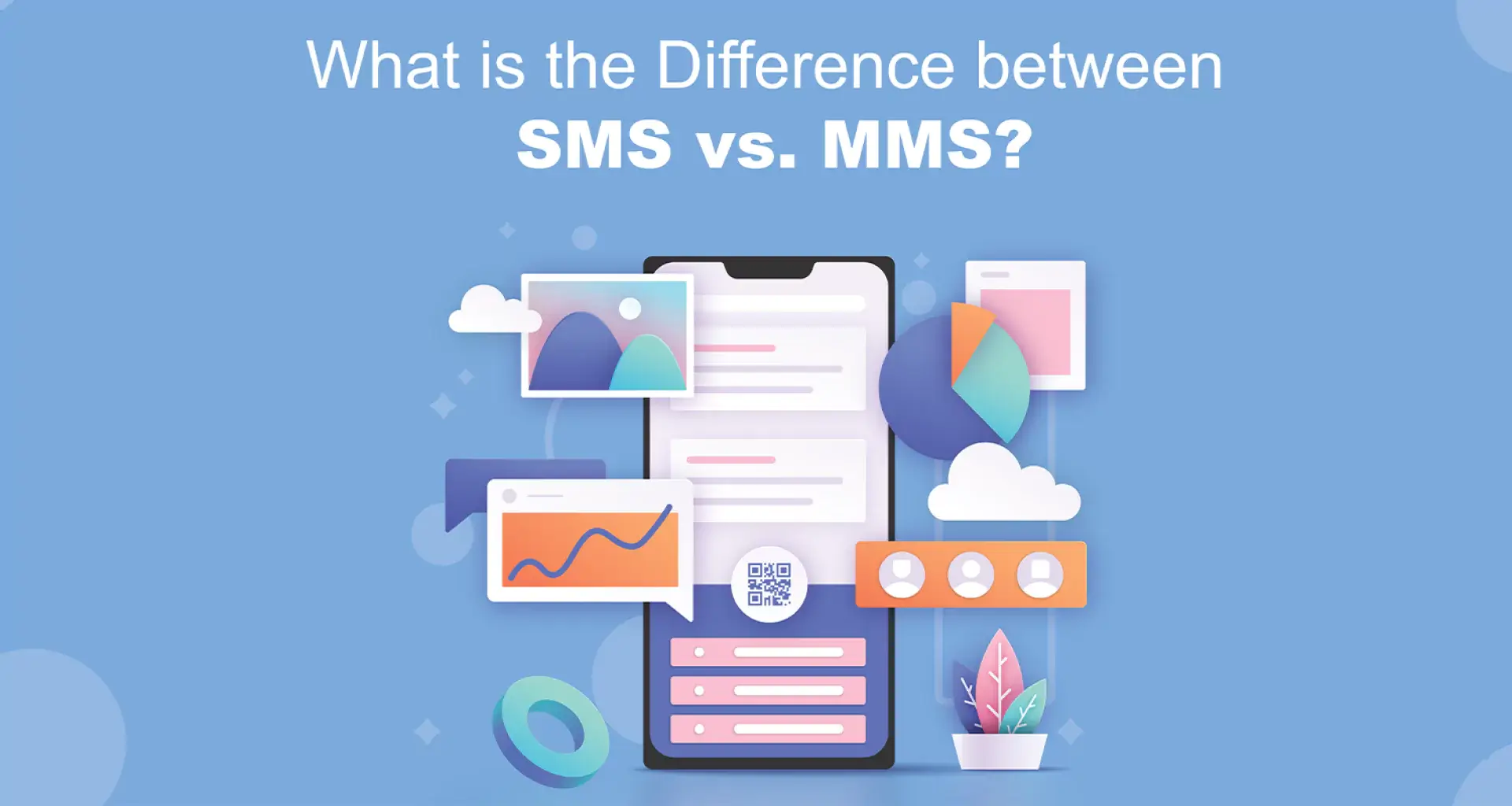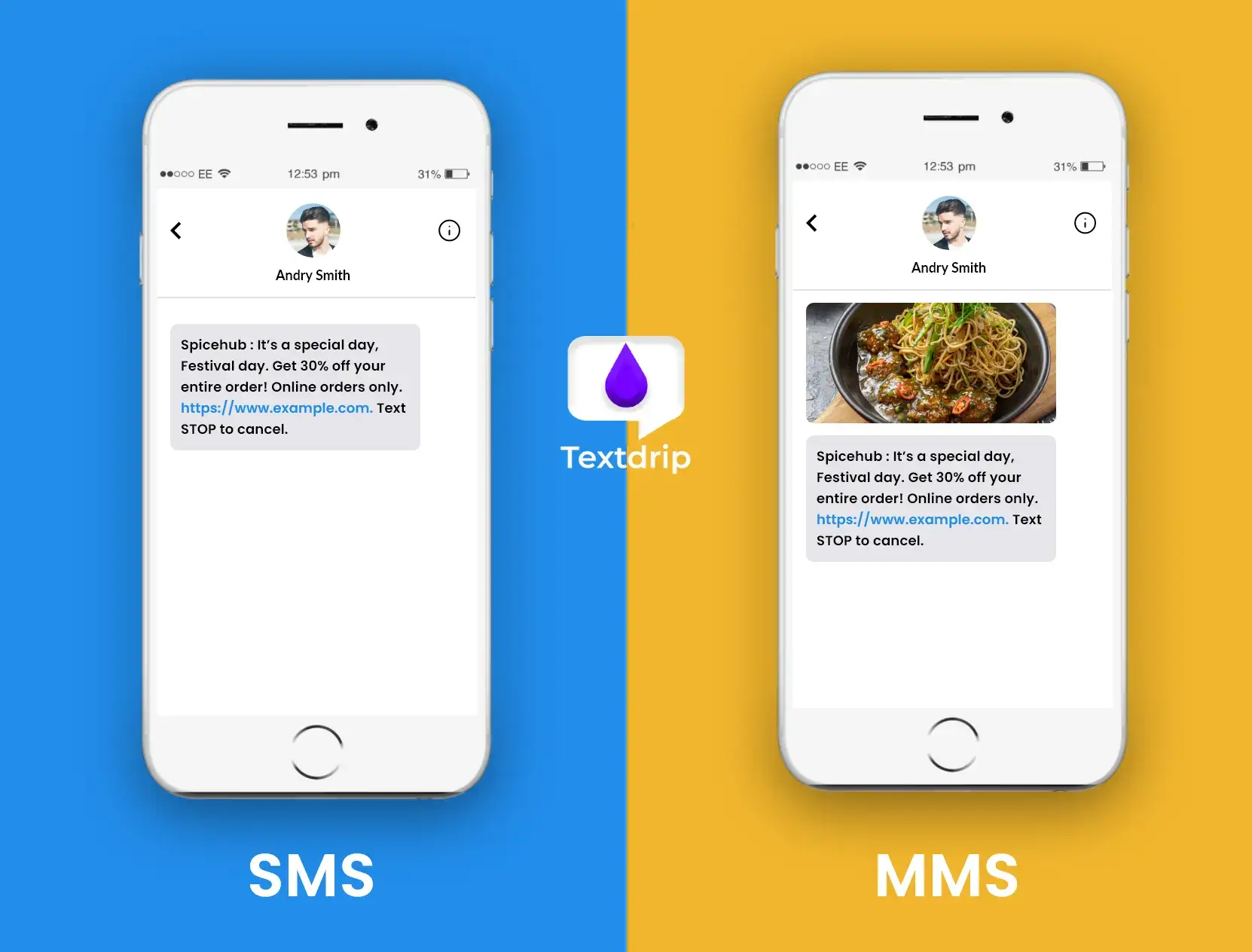31 Mar 2023
Dhaval Gajjar

31 Mar 2023
Dhaval Gajjar
From mailing letters to sending SMS, MMS, email, WhatsApp, and other means of texting, communication has now become more convenient. SMS and MMS are the two most common business communication methods to engage with customers and subscribers.
SMS or Short Messaging Service and MMS or Multimedia Messaging Service are synonymously used and confuse most people about what each means. They are used interchangeably yet there are a few significant differences between the two.
In this article, I’m going to delve into the realm of SMS vs MMS and break down the differences between SMS and MMS marketing. We’ll also explore the new terminology called RCS (Rich Communication Services). So, let’s get started by first understanding what each term means:
SMS is a form of text messaging service that uses a standardized communication protocol to allow mobile devices to share short text messages of up to 160 characters. Originating from radio telegraphy and pagers, SMS communication protocol was developed around the 1980s while the first SMS was sent on December 3rd, 1992.
SMS is a text-only communication channel, meaning you can only send and receive texts and not images, videos, audio, and other media files. Examples of SMS messages include transaction alerts, appointment reminders, and others.
Most SMS marketing platforms adorn you with the ability to text back and forth and send impactful messages and compel subscribers to take action.
MMS is also a standard way to send text messages and includes multimedia content such as images, videos, audio, etc. The MMS became commercially viable in March 2002 and was widely adopted during 2010 to 2013, partly due to the adoption of smartphones. During this period, MMS traffic increased by almost 70% from 57 billion messages to 96 billion.
Another reason for the same is MMS extended the core capabilities of SMS, allowing people to share texts greater than 160 characters while also delivering a variety of media files. Media and entertainment companies use MMS to share news and entertainment content, real estate agents send property images, while retailers use MMS to deliver scannable coupons, product images, videos, and others.
MMS also has a variety of use cases for other industries, helping them foster relationships with their subscribers and compel them to take action.
Established by industry promoters in 2007, Rich Communication Services (RCS) is a communication protocol aiming to replace SMS with a rich text-messaging system. The protocol offers enhanced messaging capabilities such as phonebook polling and transmits in-call multimedia.
RCS is a part of the broader IP multimedia subsystem that Google has incorporated into its messaging ecosystem with end-to-end encryption for all chats. With its Messages app, Google has added support for RCS on Android devices. Samsung also joined the bandwagon and updated its Samsung Experience messages app to inculcate support for RCS.

SMS and MMS marketing have their own advantages and are used based on their goals and audience preferences. While SMS is more straightforward, MMS gives you more creativity and visual impact through multimedia content. Here’s more on what’s the difference between SMS and MMS:
|
Aspect |
SMS Marketing |
MMS Marketing |
|
Message Type |
It’s Text-Only Marketing And Limited To Text Content. |
It’s A Multimedia Marketing Where Audio, Video, Or Images Are Used In Combination With Text. |
|
Content |
SMS Marketing Content Is Usually Short & Concise |
MMS Allows For Longer Text Content Along With Multimedia Files. |
|
Character Limit |
SMS Marketing Has A Character Limit Of Up To 160 Characters. |
Message Length Can Extend To 1600 Characters But Often Varies From Carrier To Carrier. |
|
Engagement |
SMS Has A Higher Open And Response Rate Due To Its Simplicity. |
MMS Messages Have Lower Engagement Compared To SMS As Recipients Might Hesitate To Download The Multimedia Files. |
|
Visual Appeal |
Almost Zero Visual Appeal Due To The Text-Only Format. |
Higher Visual Appeal Thanks To Multimedia Content. |
|
Cost |
SMS Marketing Is Generally Cost-Effective As It Uses Less Data. |
MMS Marketing Generally Costs Higher Than SMS Due To The Higher Data Usage For Multimedia Content. |
|
Delivery Method |
Sent From Mobile Phones Or Applications Through Standard Network Without Internet |
Requires Data Connection (Internet) To Send MMS Messages |
|
Delivery Time |
Instant Delivery Because Of The Less Data Consumption |
May Have A Higher Delivery Time Due To Large Text & Multimedia Files |
|
Throughput Rate |
High |
Low |
|
Use Cases |
Well-Suited For Sharing Quick Alerts, Reminders, Notifications, And Promotions. |
Effective For Sharing Product Info, Property Details, Demos, Visual Storytelling, Etc. |
|
Compatible Devices |
All Cell Phones/Mobiles Can Receive SMS Messages |
Mobile Phones With Internet Collection And Multimedia Support Can Receive MMS Messages. |
From this table, we can group differences between SMS vs. MMS into three categories: Character Limit, Multimedia Support, Delivery Method and time, and Cost. Let’s explore more:
SMS messages have a character limit of 160 characters, which gets extended with MMS messaging. While the actual text character limit depends on the carrier, most limit it to 1600 characters or 3.75MB per MMS message.
Regardless of the text character limit in MMS, you get more room to explore and experiment with your message content, tone, and CTA. This allows for better results and improves the overall bottom line for your text message marketing efforts.
As mentioned earlier, MMS includes support for multimedia files such as videos, audio, images, GIFs, etc. SMS only has support for text-based content, so you have to add links to your media files for recipients to access them.
The support for multimedia makes your MMS messages more appealing and eye-catching as people gravitate toward them, improving your campaign’s effectiveness.
Another difference between MMS and SMS is the message delivery and transmission method used. For instance, SMS messages are delivered over cellular networks using the data packets from mobile phones in P2P (Person-to-Person) or applications in A2P (Application-to-Person). The SMS is first sent to the nearest cell tower then to the message center, and finally to recipients’ devices.
Sending MMS messages is slightly more complicated than SMS messages. For starters, it involves a Multimedia Messaging Service Center (MMSC) where the message is first submitted. Then MMSC sends an SMS notification to the recipient device, which prompts the device to retrieve the MMS message.
Due to this additional infrastructure involved in sending MMS, it’s a little costlier than SMS messages. How much? Let’s get to that.
Sending 1 SMS of 160 characters consumes around 1 message credit. The cost of 1 credit varies from platform to platform, for instance, it can vary from $0.01 to $0.05. Textdrip has a simple SMS marketing pricing where 1 credit costs around $0.012 for credit top-ups below $100. For top-ups above $100, you can avail a 20% off, making the $0.0096 effective price for 1 credit/SMS.
Messages with image, video, GIF, or emoji attachments can cost around $0.05 to $0.2 per message. Most SMS marketing platforms consume 5 to 20 SMS credits. Textdrip, on the other hand, consumes 5 credits for each message with a multimedia attachment, which costs you around $0.048 to $0.6 depending on your credit top-up value.
Making an informed decision to choose SMS or MMS requires consideration of various factors including use case, message length, content type, target audience’s preferences, communication goals, etc. Here’s how you can make your decision:
SMS is best when you want to send short and concise messages such as order confirmations, appointment reminders, quick updates, asking for details, etc. SMS also comes in handy when your goal is to deliver short and urgent messages with a clear call to action. For instance, SMS is great if your goal is to generate more engagement with time-sensitive deals or online/offline events.
Additionally, the choice of SMS or MMS goes to what your audience prefers. If they prefer quick and straightforward information, SMS is the way to go, while helping you reach the mass audience.
MMS is suitable when you want to visually engage with your audience and works well for product promotions, brand building, real estate property promotions, and other marketing campaigns. Multimedia messaging comes in handy when your goal is to build an emotional rapport with users through visual storytelling.
Unlike SMS, you can attach rich and engaging content such as images, GIFs, emojis, videos, etc. However, MMS marketing should be chosen considering your audience’s preference and device compatibility where you can deliver a more immersive experience.
1. What are the key differences between SMS and MMS?
The key difference between SMS and MMS is the text character length, supported content types, delivery method, and cost. While SMS supports only plain text of up to 160 characters and is sent using a cellular network without a data connection, MMS supports multimedia files with a text character limit of around 1600 or more and requires an Internet connection. SMS is more cost-effective than MMS when using applications to send business text messages.
2. Are all devices compatible with SMS and MMS?
Almost all devices are compatible to receive text-only SMS messages while only modern devices with internet connection and multimedia support can receive MMS messages. Older devices may not have compatibility to receive MMS messages as they lack support for multimedia and internet connection.
3. Can I send mass SMS and MMS to my subscriber base?
Yes, you can send mass SMS and MMS messages to your subscribers using A2P messaging platforms such as Textdrip. However, you first need to collect opt-ins from your users with their express permission to receive messages from your business. Also, there should be a clear way for them to opt out in case they plan to stop receiving messages from you. Textdrip helps you with these regulations and also follows all the SMS and MMS compliance requirements to flourish your business SMS marketing efforts.
4. What happens if my text-only message extends beyond 160 characters?
In cases where your text-only message extends beyond 160 characters, your messages are converted into segments. Textdrip divides your message exceeding the 160 limit and converts it into multiple text segments with each segment consisting of 153 characters but sends them as one text message. Each text segment is charged 1 messaging credit. For instance, if your text message is divided into 3 text segments, it’ll consume 3 messaging credits.
We hope this article clears your doubts about what SMS and MMS marketing is and the differences between the two. While MMS is the more engaging type of messaging, it requires data connection and support for multimedia on the recipients’ devices.
SMS, on the other hand, is a quick and straightforward way to reach your subscribers without needing an internet connection or multimedia support. This makes it simple to get started with your text message marketing journey.
What’s more? You can automate your text message marketing with powerful SMS automation tools like Textdrip. Get started today by booking a demo and enjoy a free trial!